History
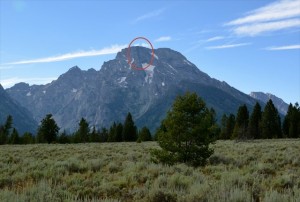 When I was about 10 years old or so, my family and my Uncle Bill’s family went to the Jackson, Wyoming area. While we were stopped at a lookout point for the Teton Mountains, my dad told a story, or maybe read the story about a plane that had crashed on Mount Moran on November 21, 1950. He told us that because of the difficulty in reaching the site, the plane and the remains of the 21 people lost in the crash were never removed from the site. My young mind could not seem to get past the fact that those bodies were still on that mountain top. I had a terrible time sleeping. I don’t know if I felt like we were somehow camping someplace we shouldn’t be, which was silly, because that site was miles from where we were camped. Nevertheless, it bothered me very much at that time. Now, many years later, I would know that the mountain was simply a burial place for the victims of a tragic crash.
When I was about 10 years old or so, my family and my Uncle Bill’s family went to the Jackson, Wyoming area. While we were stopped at a lookout point for the Teton Mountains, my dad told a story, or maybe read the story about a plane that had crashed on Mount Moran on November 21, 1950. He told us that because of the difficulty in reaching the site, the plane and the remains of the 21 people lost in the crash were never removed from the site. My young mind could not seem to get past the fact that those bodies were still on that mountain top. I had a terrible time sleeping. I don’t know if I felt like we were somehow camping someplace we shouldn’t be, which was silly, because that site was miles from where we were camped. Nevertheless, it bothered me very much at that time. Now, many years later, I would know that the mountain was simply a burial place for the victims of a tragic crash.
While I am no longer haunted by the thought of those lost ones buried in the ice at the top of the mountain, I really never lost my curiosity about the crash and just who those people were. Then, a few weeks ago, I found that today would be the 65th anniversary of that crash. It seemed like it was time to find out more about it. The plane, a new Douglas DC-3, was owned by New Tribes Mission. It was on the first leg of a trip to South America. It left Chico, California and was bound for Billings, Montana. The last radio report in was over Idaho Falls, Idaho at 3:48pm. Then it was reported overdue at Billings, leaving the sinking feeling that something tragic had happened. A resort owner said he saw a burning fuselage in the flames far above timberline on the east face of Mount Moran. When the fire subsided, he could see nothing resembling a campfire, which might have indicated survivors. Gaining access to the site was going to prove extremely difficult, and with temperatures seriously low, the chance of anyone making it through that first night were next to none. Of course, you can guess the outcome of the crash. All those on board were lost.
Removing the wreckage and the bodies of the victims proved to be a very difficult, if not impossible task, and in the end, it was decided that the wreckage and the remains would be left on the mountain. The crash site is just north of the top of the handle of Skillet Glacier. Sometimes a glint of the wreckage can be seen to this day on a sunny summer afternoon when the light is just right. The crash site remains a resting place for those lost souls, and hikers who pass the site are expected to show their respect by leaving this mountain gravesite undisturbed. The site is the burial ground for the ten men, four women, and seven children who’s remains are still entombed in the wreckage. I suppose that these days, while the plane might have been left on the mountain, the remains of the victims would have most certainly been removed allowing the families to give them a proper burial.
Hikers who have passed the wreckage have said that it has an eerie feeling. I’m sure it has to do with being so close to the remains of the victims of that horrible crash. I can totally relate to how they felt, because on that day, when we were camping just within sight of the mountain where the wreckage and the victims still remained, I could not sleep. I was not afraid of being haunted or anything silly like that, but rather I guess it felt like I was an intruder, much like the Native Americans felt when the White Man went through their burial grounds. It was just not the right place to be. I think I would feel even more like I was in the wrong place, if I ever hiked that mountain, and came upon that sight. I still have an eerie feeling about it to this day…or maybe it is just a sadness for those lost ones. I’m still not sure about that…to this day.
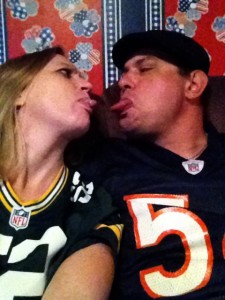 I don’t know about your family, but in my family, there are a number of “die hard” football fans. Basically the situation is this. If their team is playing, don’t walk in front of the television, unless it is a commercial. Now my husband, Bob Schulenberg and I are definitely “die hard” Broncos fans, but we don’t always watch the game. I suppose lots of people would say that if we don’t watch the games, we aren’t “die hard” fans, but I say we are. You will never see me going for another team if they are playing my Broncos. I will root for my kids teams, as long as they are not playing the Broncos. That’s just the way it is. Now, in our house, there is no big football fight, because both Bob and I agree that the Broncos are our team, but our kids have homes that are in football division, making game day a little more heated. Nevertheless, I doubt if game day was ever quite as heated in my kids houses as it was with the Heidi Bowl. For many of you, I’m sure that a question has now arisen…namely, “What is the Heidi Bowl?” In fact, I’m sure that many of you are wondering if I know anything about football at all. True enough, there are a number of Bowl games played, with the ultimate one being the Super Bowl, and yes, I do know about football, and I assure you that the Heidi Bowl did exist.
I don’t know about your family, but in my family, there are a number of “die hard” football fans. Basically the situation is this. If their team is playing, don’t walk in front of the television, unless it is a commercial. Now my husband, Bob Schulenberg and I are definitely “die hard” Broncos fans, but we don’t always watch the game. I suppose lots of people would say that if we don’t watch the games, we aren’t “die hard” fans, but I say we are. You will never see me going for another team if they are playing my Broncos. I will root for my kids teams, as long as they are not playing the Broncos. That’s just the way it is. Now, in our house, there is no big football fight, because both Bob and I agree that the Broncos are our team, but our kids have homes that are in football division, making game day a little more heated. Nevertheless, I doubt if game day was ever quite as heated in my kids houses as it was with the Heidi Bowl. For many of you, I’m sure that a question has now arisen…namely, “What is the Heidi Bowl?” In fact, I’m sure that many of you are wondering if I know anything about football at all. True enough, there are a number of Bowl games played, with the ultimate one being the Super Bowl, and yes, I do know about football, and I assure you that the Heidi Bowl did exist.
The Heidi Bowl was played on November 17, 1968. The two teams were the Oakland Raiders and the New York Jets. The game between the Jets and the Raiders was a classic nail biter. It featured two of the league’s best teams and 10 future Hall of Fame players. With a little more than a minute left to play, the Jets kicked a 26-yard field goal that gave them a 32-29 lead. After the New York kickoff, the Raiders returned the ball to their own 23-yard line. What happened after that will go down in football history. The Raiders quarterback Daryle Lamonica threw a 20 yard pass to halfback Charlie Smith. A facemask penalty moved the ball to the Jets’ 43 yard line, and on the next play, Lamonica passed again to Smith, who ran it all the way for a touchdown. The Raiders took the lead…32-36. Then the Jets fumbled the kickoff. Oakland’s Preston Ridlehuber managed to grab the ball and run it two yards for another touchdown. Oakland had scored twice in nine seconds, and the game was over. Oakland won…43-32.
I’m sure you are still wondering how this was called the Heidi Bowl. Well, I’ll tell you. At the point where the game had just 65 seconds left, NBC switched off the game and put on the movie, Heidi, which had been scheduled to start at that point. The Oakland Raiders came from behind to score two touchdowns in nine seconds. They beat the New York Jets…and no one saw it, because they’re watching the movie Heidi instead. So the only people who got to see the end of that intense game were the people in the stands. Viewers were outraged, and they complained so vehemently that network executives learned a lesson they’ll never forget. “Whatever you do,” one said, “you better not leave an NFL football game.” It didn’t matter what was scheduled…the game is played out. 
The Heidi Bowl was not a Bowl game that anyone, who loves football, ever wanted to watch, but it was one that was played, nevertheless. For anyone who doesn’t care about football, I’m sure that the thought was, “Oh for Pete’s sake, what is the problem?” Well, that was not the question for the NBC executives ever again. The problem is a huge one. Ratings!! If you want the ratings, don’t make such a big mistake as to jump out of a game 65 seconds before it’s over. Sure, most of the time there wouldn’t be much change, but you just never know…and if it does, you don’t want to deal with the aftermath.
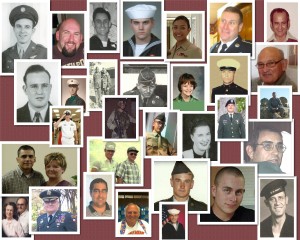 There once was a time when things like duty, sacrifice, and honor meant something. People were thankful for the service of our armed forces, who were willing to give all to ensure the freedoms we have in this nation. Sadly, these days, so many people think that our freedoms are somehow an infringement on the rights of others. They feel like freedom should be controlled by a select few…namely our government. I can’t figure out why they can’t understand that when the government controls your freedoms, you are no longer free. That’s living in a dictatorship, and not in freedom.
There once was a time when things like duty, sacrifice, and honor meant something. People were thankful for the service of our armed forces, who were willing to give all to ensure the freedoms we have in this nation. Sadly, these days, so many people think that our freedoms are somehow an infringement on the rights of others. They feel like freedom should be controlled by a select few…namely our government. I can’t figure out why they can’t understand that when the government controls your freedoms, you are no longer free. That’s living in a dictatorship, and not in freedom.
For as long as the United States has been able to form it’s own military force, we have been a people who fought for the rights of all people to think, speak, and believe as they choose…whether anyone else agrees with them or not. It was our soldiers who fought to give us those rights, and oddly enough, when people did not have the right to decide how others should think, there was far less hate and racism in this country. I realize that when people are allowed to worship, think, speak, and write as they choose, there will be disagreement with their opinions, and that’s ok. Disagree with me all you like, just don’t try to tell me that I have to think the way you think, and I will show you the same courtesy.
Our military personnel go to war whenever asked, whether it is a holiday or not. They can’t stop defending us and other nations just because it’s Thanksgiving or Christmas. They get up and they fight on. They don’t have the luxury of a 9 to 5 job, but rather must be prepared to battle well into the night and even into the next day, because the enemy doesn’t take a break. There has never really been a time in our history when things were in more turmoil. There are those, even within our own borders who hate this nation and all it stands for. Those people have no honor, no sense of duty or pride in our nation, and they certainly don’t understand the sacrifices our military personnel made to give them the freedom to be so hateful toward those who are just stating their opinion.
Today is Veteran’s Day. It is a day set aside to honor those who have fought for this nation and others. It is a day to remember those who gave their lives that others might live in freedom. In reality, we owe them so much more than we could ever repay, but most of all, we owe them respect. Veteran’s Day is a day to tell our veterans just how much they mean to us. Be sure to thank a veteran today, and to all Veterans, Happy Veterans Day. Thank you for your service. Your sacrifice will never be forgotten.
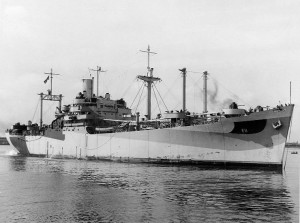 Any time ammunition, explosives, and bombs are being stored in a smaller space, and handled by multiple people, there is a possibility of disaster. The USS Mount Hood was the lead ship of her class of ammunition ships for the United States Navy in World War II. Her life was short lived. The North Carolina Shipbuilding Company began work on the ship on September 28, 1943, and the intended name of the ship was SS Marco Polo. It was first launched on November 28, 1943, and aquired by the Navy on January 28, 1944. It was commissioned the USS Mount Hood on July 1, 1944. The ship was named after Mount Hood, the volcano in the Cascade Range in Oregon.
Any time ammunition, explosives, and bombs are being stored in a smaller space, and handled by multiple people, there is a possibility of disaster. The USS Mount Hood was the lead ship of her class of ammunition ships for the United States Navy in World War II. Her life was short lived. The North Carolina Shipbuilding Company began work on the ship on September 28, 1943, and the intended name of the ship was SS Marco Polo. It was first launched on November 28, 1943, and aquired by the Navy on January 28, 1944. It was commissioned the USS Mount Hood on July 1, 1944. The ship was named after Mount Hood, the volcano in the Cascade Range in Oregon.
Following a short fitting out and shakedown period in the Chesapeake Bay area, the USS Mount Hood reported for duty to ComServFor, Atlantic Fleet on August 5, 1944. She was assigned to carry cargo to the Pacific, and she pulled in to Norfolk, where her holds were loaded. The she was transfered to the Panama Canal as part of 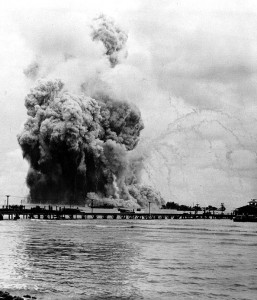 Task Group 29.6. She finally ended up Seeadler Harbor at Manus Island of the Admiralty Islands on September 22, 1944. There she was assigned to ComSoWesPac. The ship was to be dispensing ammunition and explosives to ships preparing for the Philippine offensive.
Task Group 29.6. She finally ended up Seeadler Harbor at Manus Island of the Admiralty Islands on September 22, 1944. There she was assigned to ComSoWesPac. The ship was to be dispensing ammunition and explosives to ships preparing for the Philippine offensive.
At 8:30am, on November 10, 1944, 17 of USS Mount Hood’s crew members, including Lieutenant Lester H Wallace left the ship to go ashore. At 8:55am, while walking on the beach the men saw a flash and heard two quick explosions. They immediately jumped back in their boat and headed for their ship, only to find that, like volcanoes tend to do, the USS Mount Hood had exploded. There was literally no ship to come back to, and other ships in the area were heavily damaged too. The USS Mount Hood had been anchored in 35 feet of water, and had exploded with an estimated 3,800 tons of ordnance material on board. Mushrooming smoke rose to 7,000 feet, completely obscuring the ship and the surrounding area for approximately 500 yards. It was easy to see where USS Mount Hood had been, because the explosion created a trench in the ocean floor 1,000 feet long, 200 feet wide, and 40 feet deep.The largest remaining piece of the hull was found in the trench and measured about 16 feet by 10 feet. No other remains were found except the fragments which struck the other ships in the area. No human remains were recovered of the 350 men aboard USS Mount Hood or the small boats loading alongside at the time of the explosion.

There were 271 men in surrounding ships that were injured, and 82 of nearby Mindanao’s crew were killed. In all, 22 small boats and landing craft were sunk, destroyed, or damaged beyond repair. The exact cause of USS Mount Hood’s explosion was never determined, but since the possibility of enemy action was remote, it was thought that rough handling of some of the explosives during the loading and unloading process was to blame for the disaster. With no survivors and so little of the ship left, I’m sure that the investigation was an impossible task. I do find it ironic that a ship named after a volcano, ended up exploding, and I find the loss of life to be a very sad thing indeed.
 When you are a lot like another person, you carry memories of that person around with you. The strange thing about it is that you probably don’t even notice those similarities during that person’s lifetime. Often it is after their death, that suddenly things like their laugh coming out of you, has a tendency to startle you. Something, like being built like that person is always something you knew, and yet, things like looking like that person, may not be something you could see, until you looked at a picture of yourself, and you can totally see that person. I suppose that different hair styles and the use of make up can make a difference in each one’s looks, but eventually, something just stands out, and you know that you are that person’s mini me…even if that person is not your parent, but rather and aunt, as in my case. I never thought of myself as being anyone’s mini me, but in the case of my aunt and me, that is clearly the case.
When you are a lot like another person, you carry memories of that person around with you. The strange thing about it is that you probably don’t even notice those similarities during that person’s lifetime. Often it is after their death, that suddenly things like their laugh coming out of you, has a tendency to startle you. Something, like being built like that person is always something you knew, and yet, things like looking like that person, may not be something you could see, until you looked at a picture of yourself, and you can totally see that person. I suppose that different hair styles and the use of make up can make a difference in each one’s looks, but eventually, something just stands out, and you know that you are that person’s mini me…even if that person is not your parent, but rather and aunt, as in my case. I never thought of myself as being anyone’s mini me, but in the case of my aunt and me, that is clearly the case.
My Aunt Ruth is the aunt that I really look like, and laugh like, and yet it was after her passing that it suddenly dawned on me that I really do laugh like her. Aunt Ruth had a great sense of humor, and she loved to laugh. She was a woman who had been a lot of places, and that made her seem to me to be very sophisticated, but Aunt Ruth would never have considered herself to be some fancy woman of the world. She had just lived in several places, and that gave her some knowledge of how things  worked in some of the glamorous places that I had not been in or at least not very long, but she knew them well.
worked in some of the glamorous places that I had not been in or at least not very long, but she knew them well.
One of the memories I will always have of Aunt Ruth, is the moccasins she always wore. I don’t know if she loved the Native American culture or if the moccasins were just comfortable, but she loved them. She always wore the ones with the tiny bead work on them, and for some reason, my little girl mind always thought those were special. I’m sure that it was because my Aunt Ruth wore them. When you look up to someone, you really think that everything they do is the coolest thing in the world. Aunt Ruth left us in 1992, and we all miss her very much, but for me, there is the fact that in many way, I am so much like her, and it is like carrying her memory with me. Today would have been Aunt Ruth’s 90th birthday. Happy birthday in Heaven, Aunt Ruth. We love and miss you very much, and can’t wait to see you again.
 At some point in every life, there comes a need for X-rays. It might be a broken bone, as it was this time for me, when I broke my shoulder three weeks ago, or it might be at the dentist, as he looks for cavities in your teeth, but I think pretty much everyone has an X-ray at some point. This process is so common, that most of us give it little or no thought, but prior to November 8, 1895, X-rays didn’t exist. It was on this day in 1895…120 years ago, that physicist Wilhelm Conrad Röntgen became the first person to observe X-rays. This was a huge scientific advancement that would ultimately benefit a variety of fields, but most of all medicine, by making the hidden things visible. Before the discovery of X-ray, broken bones, tumors, and the location of bullets were all diagnosed by physical examination and a doctor’s best guess. It’s no wonder so many people didn’t survive their injuries or illnesses.
At some point in every life, there comes a need for X-rays. It might be a broken bone, as it was this time for me, when I broke my shoulder three weeks ago, or it might be at the dentist, as he looks for cavities in your teeth, but I think pretty much everyone has an X-ray at some point. This process is so common, that most of us give it little or no thought, but prior to November 8, 1895, X-rays didn’t exist. It was on this day in 1895…120 years ago, that physicist Wilhelm Conrad Röntgen became the first person to observe X-rays. This was a huge scientific advancement that would ultimately benefit a variety of fields, but most of all medicine, by making the hidden things visible. Before the discovery of X-ray, broken bones, tumors, and the location of bullets were all diagnosed by physical examination and a doctor’s best guess. It’s no wonder so many people didn’t survive their injuries or illnesses.
When I broke my shoulder, having the X-rays was something I really gave no thought to, other than sitting there with my shoulder hurting while the technicians did their jobs. Of course, looking at the X-rays of my broken shoulder was interesting. I suppose that comes from my caregiver side. Since taking care of my parents 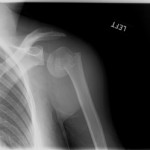 and in-laws, I can honestly say that I have looked at more X-rays than I can count. Each one held an interest to me. It cleared up the mystery of what was wrong with my loved one, and now myself. I have to think too, that were it not for the ability to do X-rays, my surgery to put a plate and nine screws in my shoulder bone, would not have been possible, or at least not easy to do. I’m sure that my prognosis would have been much different. X-rays have made so many things possible, and they aren’t even limited to the medical field. They have helped in many fields. Other than medicine, the other original use for X rays was in studying the inner structure of materials. By firing a beam of X rays at a crystal, the atoms scatter the beam in a very precise way, casting a kind of shadow of the crystal’s interior pattern from which you can measure the distance between one atom and nearby atoms. X-rays are used in airports to look into carry on items to ensure the safety of the passengers on the flight. The criminal justice system has used dental and other X-rays for some time to identify unknown crime victims. X-rays are being used to identify the elements of paintings done by the masters to find out what kind of pigment was used. They help to determine the age of paintings, whether they are genuine or copies and how the pigments change over time. X-rays have improved the work of so many people, by making the hidden things visible.
and in-laws, I can honestly say that I have looked at more X-rays than I can count. Each one held an interest to me. It cleared up the mystery of what was wrong with my loved one, and now myself. I have to think too, that were it not for the ability to do X-rays, my surgery to put a plate and nine screws in my shoulder bone, would not have been possible, or at least not easy to do. I’m sure that my prognosis would have been much different. X-rays have made so many things possible, and they aren’t even limited to the medical field. They have helped in many fields. Other than medicine, the other original use for X rays was in studying the inner structure of materials. By firing a beam of X rays at a crystal, the atoms scatter the beam in a very precise way, casting a kind of shadow of the crystal’s interior pattern from which you can measure the distance between one atom and nearby atoms. X-rays are used in airports to look into carry on items to ensure the safety of the passengers on the flight. The criminal justice system has used dental and other X-rays for some time to identify unknown crime victims. X-rays are being used to identify the elements of paintings done by the masters to find out what kind of pigment was used. They help to determine the age of paintings, whether they are genuine or copies and how the pigments change over time. X-rays have improved the work of so many people, by making the hidden things visible.

Röntgen’s discovery of the X-ray was really by accident. He was in his lab in Wurzburg, Germany, where he was testing whether cathode rays could pass through glass when he noticed a glow coming from a nearby chemically coated screen. Because he really didn’t know exactly what kind of rays these were, he called them X-rays. I have often wondered just why they were called X-rays. Now I know. It was all because X means unknown. It’s almost funny to call something unknown, when it reveals the hidden things, making them known. No matter what it is called, it is, nevertheless, an amazing find and an amazing advancement in the medical field, and so many others too.
 When we think of hurricanes, we think of the ocean, but on November 7, 1913, there was a storm over the Great Lakes that would go down in United States history as the largest inland maritime disaster, in terms of number of ships lost. The storm was nicknamed the White Hurricane. The storm system brought blizzard conditions to areas all around the Great Lakes, with hurricane force winds. The nature of the storm was unique and powerful, and caught even the most seasoned captain by surprise. Two low pressure centers merged and rapidly intensified over the Lake Huron, with periods of storm-force winds occurring over a four day period. Surrounding ports signaled it was a level-four storm, but for some vessels, it was already too late. Major ship wrecks took place on all the Great Lakes except for Lake Ontario. Vessels at that time could withstand 90 mile per hour winds and 35 foot waves, but it was the whiteout conditions and accumulation of ice on the ships that turned an already dangerous situation into a deadly one. Ship captains were unable to maintain navigation, resulting in 12 shipwrecks, 19 ships stranded, and an estimated 250 lives lost. On land, 24 inches of snow shut down traffic and communication, causing millions of dollars in damage.
When we think of hurricanes, we think of the ocean, but on November 7, 1913, there was a storm over the Great Lakes that would go down in United States history as the largest inland maritime disaster, in terms of number of ships lost. The storm was nicknamed the White Hurricane. The storm system brought blizzard conditions to areas all around the Great Lakes, with hurricane force winds. The nature of the storm was unique and powerful, and caught even the most seasoned captain by surprise. Two low pressure centers merged and rapidly intensified over the Lake Huron, with periods of storm-force winds occurring over a four day period. Surrounding ports signaled it was a level-four storm, but for some vessels, it was already too late. Major ship wrecks took place on all the Great Lakes except for Lake Ontario. Vessels at that time could withstand 90 mile per hour winds and 35 foot waves, but it was the whiteout conditions and accumulation of ice on the ships that turned an already dangerous situation into a deadly one. Ship captains were unable to maintain navigation, resulting in 12 shipwrecks, 19 ships stranded, and an estimated 250 lives lost. On land, 24 inches of snow shut down traffic and communication, causing millions of dollars in damage.
The storm took place before the time when weather forecasters had the luxury of computer models, the detailed surface and upper air observations, weather satellites, or radar needed to make the most accurate predictions. Had weather forecasters then been able to access modern forecasting equipment, they may have been able to determine the likely development of this type of storm system in advance, as they did with Superstorm Sandy in 2012. As part of the forecast for Sandy forecasters were able to predict storm force winds over the lower Great Lakes five days in advance. The technology and forecast models available to forecasters today led to a more accurate forecast which saved mariners, recreational boaters, and businesses millions, as they were able to make preparations in advance of Sandy’s storm force winds and near 20 foot waves.
One hundred years later, the National Oceanic and Atmospheric Administration, in the Great Lakes is commemorating the Storm of 1913, not only for the pivotal role it played in the history of the Great Lakes, but also for its enduring influence. Modern systems of shipping communication, weather prediction, and storm preparedness have all been fundamentally shaped by the events of November 1913. It’s strange to think that one storm could make such a lasting impact on so many systems, but then it is the need for something better that spurs great inventive minds to invent a solution to a serious problem.
The National Oceanic and Atmospheric Administration plays a major role in protecting maritime relics of the past. Included are many of the ships lost in 1913. They have remained preserved deep below the surface of the Great Lakes. The National Oceanic and Atmospheric Administration’s Thunder Bay National Marine Sanctuary is a 48-square-mile area of protected territory with one of America’s best preserved and nationally significant collections of shipwrecks. Located in northwestern Lake Huron, Thunder Bay is adjacent to one of the most treacherous stretches of water within the Great Lakes system. Unpredictable weather, murky fog banks, sudden gales, and rocky shoals earned the area the name “Shipwreck Alley.” To date, more than 50 shipwrecks have been discovered within the sanctuary including the Isaac M. Scott, a 504 foot steel freighter lost in the storm of 1913.
This storm holds an interest for me, because at that time in history, my grandparents, Allen and Anna Spencer were living in the Great Lakes area. My grandfather was not part of the crew of any ship, and so any effect to them would have come in the form of very deep snow. My Aunt Laura would have been just 16 months old at 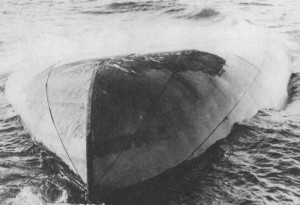 the time. I’m sure that the thought of being stranded in her home, was not a pleasant one for my grandmother, considering Aunt Laura’s very young age, but they survived the White Hurricane, as did most other people, at least those on land anyway. It still seems incredible to me that a storm of that magnitude could have brewed in an inland setting, but then anyone who knows the Great Lakes will tell you that they are so big that they might just as well be considered a sea. The November Gales have long been known as killers, especially over Lake Superior, the largest of the Great Lakes. I’m glad that modern weather forecasting equipment had at least lessened the possibility of ships and lives being lost in the Great Lakes, as well as the oceans.
the time. I’m sure that the thought of being stranded in her home, was not a pleasant one for my grandmother, considering Aunt Laura’s very young age, but they survived the White Hurricane, as did most other people, at least those on land anyway. It still seems incredible to me that a storm of that magnitude could have brewed in an inland setting, but then anyone who knows the Great Lakes will tell you that they are so big that they might just as well be considered a sea. The November Gales have long been known as killers, especially over Lake Superior, the largest of the Great Lakes. I’m glad that modern weather forecasting equipment had at least lessened the possibility of ships and lives being lost in the Great Lakes, as well as the oceans.
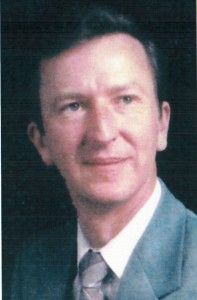 My cousin, Gene Fredrick was a man of many talents. He was the oldest of his parents’ two sons. His parents were Fritz Fredrick and Laura Spencer Fredrick, my aunt. As a boy, Gene was the helpful older brother, helping his mommy with his little brother, Dennis, who was always known to my sisters and me as Denny. Following their parents’ divorce, my Aunt Laura brought her sons to Casper, Wyoming to live near her sister, Ruth Spencer Wolfe, and her husband Jim, who were living there at the time. Casper was also where my parents would settle in 1959, and that meant that my family got to see our cousins, Gene and Denny Fredrick and Shirley, Larry, and Terry Wolfe quite a bit. Those were great times.
My cousin, Gene Fredrick was a man of many talents. He was the oldest of his parents’ two sons. His parents were Fritz Fredrick and Laura Spencer Fredrick, my aunt. As a boy, Gene was the helpful older brother, helping his mommy with his little brother, Dennis, who was always known to my sisters and me as Denny. Following their parents’ divorce, my Aunt Laura brought her sons to Casper, Wyoming to live near her sister, Ruth Spencer Wolfe, and her husband Jim, who were living there at the time. Casper was also where my parents would settle in 1959, and that meant that my family got to see our cousins, Gene and Denny Fredrick and Shirley, Larry, and Terry Wolfe quite a bit. Those were great times.
Of course, Gene and Denny were the oldest cousins, and so they married and while they both still lived in Casper, we got to see their children too. Gene and his wife Paula had two sons, Tim and Shawn, and Denny and his wife, Sandy had a son named David. Later they both moved away, so we didn’t get to see them very much. I’ve always felt sad that we lost touch, and I am grateful that we have Facebook now, and that has given us a way to reconnect.
Gene was always a soft spoken man, who shared so much of himself with his sons. He loved to make furniture, and was very talented at it. He also 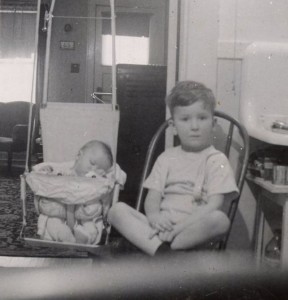 connected with our Uncle Bill, who has always loved the family history, but didn’t have the equipment or know how to scan pictures, or a computer to research people or organize the information. Gene became Uncle Bill’s right hand man, helping to get the family history in the organized condition I found it when my cousin Bill sent it to me to allow me to scan it. I can honestly say that we all owe Gene a debt of gratitude for all the help he gave Uncle Bill.
connected with our Uncle Bill, who has always loved the family history, but didn’t have the equipment or know how to scan pictures, or a computer to research people or organize the information. Gene became Uncle Bill’s right hand man, helping to get the family history in the organized condition I found it when my cousin Bill sent it to me to allow me to scan it. I can honestly say that we all owe Gene a debt of gratitude for all the help he gave Uncle Bill.
Gene taught his sons anything they were interested in. Tim tells about the years when he started becoming interested in photography. They set up a dark room, and Tim learned photography. I don’t know if Gene already knew how to develop pictures before, but they worked it together. Tim tells of making new prints from the old damaged ones. I think that Gene was an amazing man. Today would have been 76 years old today. Happy birthday in Heaven, Gene. We are all in your debt. We love and miss you.
 The years in American history during which people held slaves, were in my opinion, sad, dark years. I don’t like the idea of anyone being a slave to another person. Nevertheless, it is a part of our history, that ended when Abraham Lincoln freed the slaves effective January 1, 1863, which also brought about his own death be assassination.
The years in American history during which people held slaves, were in my opinion, sad, dark years. I don’t like the idea of anyone being a slave to another person. Nevertheless, it is a part of our history, that ended when Abraham Lincoln freed the slaves effective January 1, 1863, which also brought about his own death be assassination.
As a girl in junior high school, I read a book about Harriet Tubman and The Underground Railroad. The book so impressed me, that I have never forgotten it. Harriet was a conductor, as they were known, on the Underground Railroad. The conductors lead slaves who had escaped, along designated trails, in extreme secrecy, mostly at night, from the south to the north, and often into Canada. Harriet’s code  name was “Moses” and she was one of the most famous conductors in history, although there are several others too.
name was “Moses” and she was one of the most famous conductors in history, although there are several others too.
One of the other conductors was Samuel Burris. Burris was a free African-American, who was caught helping a slave try to escape from Delaware in 1847. Burris was caught, tried, and found guilty of “enticing slaves” to escape. As part of his sentence, he was sold into slavery for seven years. Instead, a Pennsylvania anti-slavery society raised the money to purchase him and set him free. Burris went right back to helping slaves escape.
From what I read, and from what history has told us, these conductors were very committed to this, and that makes sense when you think about the fact that they held the very lives of their cargo or passengers, which is what they called the escaped slave, and their own life in their hands. Harriet Tubman made 13 trips on the Underground Railroad bringing seventy people to freedom. She was able to say that she had “never lost a passenger” in all that time. I don’t know how many Samuel Burris helped to escape, but I’m sure it was quite a number too.
Samuel Burris family has been working for years to  have him pardoned for the crimes he was convicted of, and finally, today, November 2, 2015, Samuel Burris was pardoned. His grand niece, Ocea Thomas of Atlanta was interviewed for television Tuesday, and she said that she received a phone call last weekend letting her know Delaware Governor, Jack Markell has decided to posthumously pardon Burris for his conviction that was 150 years ago. I think that is awesome, and I think all the conductors who were convicted of crimes concerning the freedom of slaves should also be pardoned. After all, the crimes they were convicted of aren’t even crimes anymore.
have him pardoned for the crimes he was convicted of, and finally, today, November 2, 2015, Samuel Burris was pardoned. His grand niece, Ocea Thomas of Atlanta was interviewed for television Tuesday, and she said that she received a phone call last weekend letting her know Delaware Governor, Jack Markell has decided to posthumously pardon Burris for his conviction that was 150 years ago. I think that is awesome, and I think all the conductors who were convicted of crimes concerning the freedom of slaves should also be pardoned. After all, the crimes they were convicted of aren’t even crimes anymore.
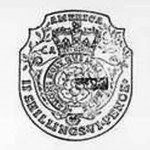 During the years that the colonies were still a part of Great Britain, it was necessary to have troops from Great Britain come and help to defend us during the French and Indian War which took place between 1754 to 1763, and Pontiac’s Rebellion from 1763 to 1764. These were quite costly wars, and to help with recuperate the losses, Great Britain enacted the Sugar Act, which while irritating to the people of the colonies, but it was hidden in the cost of import duties, and so the people accepted it. The enactment of The Stamp Act was a different story, however. The Stamp Act was a tax that Great Britain levied on just the colonies and was strongly disputed. So strongly in fact, that it led to the Revolutionary War.
During the years that the colonies were still a part of Great Britain, it was necessary to have troops from Great Britain come and help to defend us during the French and Indian War which took place between 1754 to 1763, and Pontiac’s Rebellion from 1763 to 1764. These were quite costly wars, and to help with recuperate the losses, Great Britain enacted the Sugar Act, which while irritating to the people of the colonies, but it was hidden in the cost of import duties, and so the people accepted it. The enactment of The Stamp Act was a different story, however. The Stamp Act was a tax that Great Britain levied on just the colonies and was strongly disputed. So strongly in fact, that it led to the Revolutionary War.
The Stamp Act was not what people might think it was. It was not when the use of postage stamps were first introduced. The Stamp Act went so much further than that. The Stamp Act was designed to force colonists to use special stamped paper in the printing of newspapers, pamphlets, almanacs, and playing cards, and to have a stamp embossed on all commercial and legal papers. The stamp itself displayed an image of a Tudor rose framed by the word “America” and the French phrase Honi soit qui mal y pense, meaning ”Shame to him who thinks evil of it.” Of course, the cost of said paper was high, and the colonists ere outraged. This was taxation, without representation, and it was not going to be tolerated.
Massachusetts politician Samuel Adams organized the secret Sons of Liberty organization. They planned protests against the measure, and the Virginia legislature and other colonial assemblies passed resolutions opposing the act. In October, nine colonies sent representatives to New York to attend a Stamp Act Congress, where resolutions of “rights and grievances” were framed and sent to Parliament and King George III. Their voices landed on deaf ears, and The Stamp Act was enacted on this day, November 1, 1765.
The colonists acted quickly. The arrival of the stamps to stamp the paper brought violence and economic retaliation. The colonists began a general boycott of British goods. The Sons of Liberty staged attacks on the customhouses and homes of tax collectors in Boston. The protests and economic turmoil went on for months. Finally, Benjamin Franklin appealed to the British House of Commons. Parliament took a vote, and they repealed The Stamp Act in March 1766. The same day, they made the mistake of passing Declaratory Acts, stating that the British government had free and total legislative power over the colonies.
This would prove to be their downfall. Parliament attempted to force unpopular taxation measures on the American colonies in the late 1760s. This action lead to a steady, and eventually complete, deterioration in British-American relations that brought about the outbreak of the American Revolution in 1775, and the eventual Declaration of Independence of America from Great Britain. It was a hard lesson for Great Britain to  learn, and on that some political parties, namely the Democrats have not learned yet. When you tax the people too heavily, they will rebel, and the outcome will not be in the favor of that abusive government. If taxes are lower, the country will grow. Entrepreneurs will begin new ventures, and the country will prosper, and with prosperity, comes the natural process of more money to run the government. Ours is a nation of independent thinkers, and people of action. Taxes that are too high and unfair, stifle that independent thinking and slow down that action. It is just the opposite of what the proponents of a grossly obese government would expect, but it is nevertheless, the way it works. Our government would do well to realize that, and make a change.
learn, and on that some political parties, namely the Democrats have not learned yet. When you tax the people too heavily, they will rebel, and the outcome will not be in the favor of that abusive government. If taxes are lower, the country will grow. Entrepreneurs will begin new ventures, and the country will prosper, and with prosperity, comes the natural process of more money to run the government. Ours is a nation of independent thinkers, and people of action. Taxes that are too high and unfair, stifle that independent thinking and slow down that action. It is just the opposite of what the proponents of a grossly obese government would expect, but it is nevertheless, the way it works. Our government would do well to realize that, and make a change.

